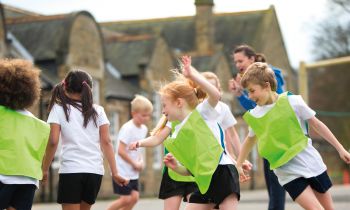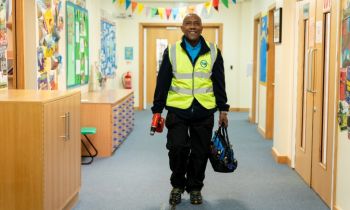At Malton Primary School we follow a whole school approach to general physical activity, with traditional break times and PE learning – but we also embrace the use of physical activity as a pedagogical tool, rather than seeing at something distinct from classroom learning.
At break and lunch times children choose whether take part in physical activities and decide how active they’re going to be. By incorporating physical activity into ‘learning time’ and using it to enhance learning that’s already taking place, there’s no opt out. The children come to simply see it as part of the learning process.
Active starters
We use ‘active starters’, so that the first three to four minutes of a lesson incorporate some form of physical activity. This might involve, for example, using the body to spell words linked to the classroom topic, using low level activity to ignite the learning experience at the start of the lesson.
We’ll also use ‘brain boosters’ after 20 to 30 minutes of sedentary work. These are short, three to four-minute bursts of physical activity, again linked to the relevant topic, which help improve the children’s concentration, levels of engagement and ability to focus.
Another part of our approach is how we’ve configured our classroom environments. If there are 25 children within a class, there won’t be 25 tables and chairs. Instead, we’ll have 16 tables and chairs and spaces where children can work while standing.
Our work in this area has been a long-term project that began with the introduction of Sport Premium funding. We then took a more proactive approach to active earning from 2015 onwards, initially with our changes to the classroom environment. Our thinking was that instead of attempting to change 25 individual behaviours in 25 different ways, the environment can do some of the work for you.
A Pragmatic approach
Overall, the staff at the school have been very receptive and supportive of active learning. It can be a challenging thing for teachers to integrate into their practice, but ours have been highly supported.
We’ve not asked them to incorporate physical activity within the confines of a Victorian classroom where space is limited, and we’ve sought to be pragmatic. Teachers aren’t required to ‘do’ active learning at set times, but get to decide on what works for them and their pupils throughout the day.
We also include subject warm-ups as part of the children’s PE lessons. As well as helping to incorporate some wider learning into those lessons, these take away the need for class teachers to teach them the nuts and bolts of particular activities. The children will be familiar with them already, allowing the teacher to focus on delivering the learning content.
Ultimately, we’re engaged in an iterative process that continues to involve regular tinkering. The biggest impact it’s had for us so far is on the children’s learning behaviours and engagement. We’ve seen a significant reduction in cases of extreme and disruptive classroom behaviour, and behaviour across the school’s shared spaces has improved. The children are now increasingly more engaged in, and more excited by their learning.
Richard Allman is PE lead at Malton Community Primary School, North Yorkshire; readers can learn more about the school’s active learning approach in a webinar that’s accessible via yhlearning.co.uk/courses/physically-active-learning.









